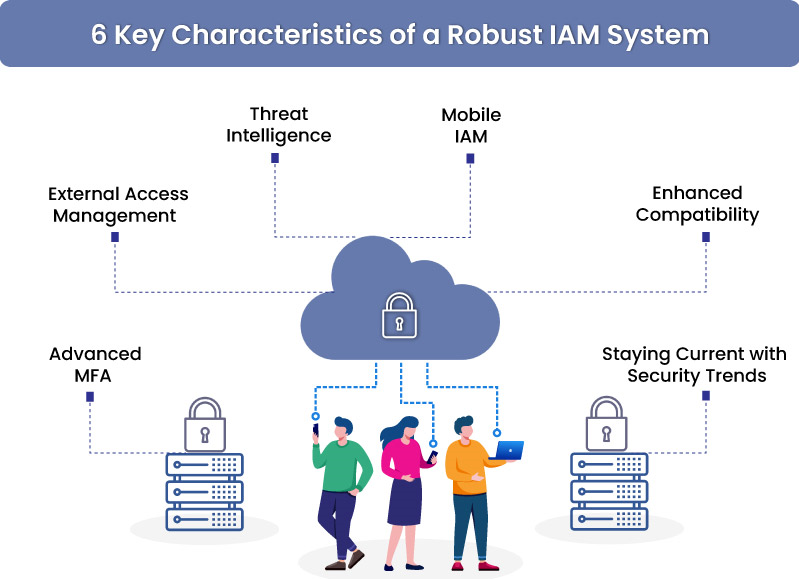Enterprises today are migrating to the cloud at an unprecedented pace to weather the business challenges spawned amid the pandemic. In a manner of speaking, the crisis has served as a de facto catalyst for cloud adoption. However, the sudden switch to cloud is breeding a digital identity crisis of sorts.
Due to the burgeoning demand, the current identity access management systems are increasingly overwhelmed. Of late, certifying access rights across multiple devices and servers has become an arduous process. Even if companies manage to do so at a swift pace, those rights are often not fully defined or understood. This lack of comprehension is paving the way for unnecessary risks and productivity drain. As managers run from pillar to post to configure access, employees wait for ages desiring clarity.
Companies should reexamine and renovate their current IAM systems with features designed to address today’s multifaceted access requirements.
Here are some key aspects organizations must consider to achieve a robust IAM solution:
6 Key Characteristics of a Robust IAM System
1. Advanced MFA
Passwords are not enough anymore. For a fact, stealing passwords and breaching data servers have become a cakewalk for cybercriminals. The Colonial Pipeline ransomware attack vindicates this observation. Darkside hackers penetrated Colonial’s network through a VPN account that only had single-factor authentication.
Now is the time for organizations to add MFA to their access controls. Multi-factor authentication prevents unauthorized access by requiring users to provide additional authentication factors beyond a password before access is granted.
Biometrics, OTPs, or email links are some of the common factors MFA uses to ensure the right access to the right user. This dynamic password prevents cybercriminals from gaining access to enterprise networks even after having obtained compromised credentials.
2. External Access Management
Organizations must pursue a holistic approach to identity access management. One must approach enterprise and external identities with a similar philosophy. Though providing access to external users, including partners, customers, and vendors, is risky, it is imperative for business growth.
Ensure that your IAM solution is built to provide seamless access to external identities across diverse IT environs with the same degree of security as employee-centric IAM systems.
3. Threat Intelligence
Threat intelligence is a must-have element of an IAM system. Businesses need to respond swiftly to security threats, and that requires real-time monitoring and response. An IAM system with ingrained threat intelligence will help quickly detect suspicious activities and trigger an alert for a prompt response. In addition, it takes immediate actions to double down on trust levels or suspend suspicious accounts. Companies ought to hire a third-party cloud provider such as Veritis to monitor and swat away the threats as they emerge.
4. Mobile IAM
Organizations are compelled to adopt remote working to ensure business continuity amid the pandemic. And the new normal is here to stay.
On the flip side, remote working has become a gateway for new forms of data theft, posing a severe security risk to businesses. To prevent this, organizations must ensure that only valid devices or systems can connect to the enterprise network and control what data the device is authorized to receive and transmit. To achieve this, organizations ought to implement an identity and access management solution with features to secure mobile and remote environments.
5. Enhanced Compatibility
Business processes often span multiple IT environs. Therefore, organizations must ensure that the IAM solution is compatible with multiple network architectures, OS, and business systems. It is wise to choose an IAM system that can flexibly integrate and synchronize directories and identity-related data across known and unknown applications and systems.
6. Staying Current with Security Trends
Cybersecurity trends are ever-evolving, and so should IAM. Diminishing digital walls, changing user access behaviors, and emerging technologies escalate the need for a versatile IAM solution. Therefore, organizations must take flexibility into consideration when choosing an identity access management service. The IAM system must not only be equipped for current business needs, but it should also be future-proofed.
Final Thoughts
A holistic identity access management strategy hammered out with the above practices helps prevent digital identity crisis. Most of all, a unified digital identity approach enables optimal end-user experience without compromising on security.
Given the growing ubiquity of remote working, it is more likely that the operating environment for identity management will become increasingly complex. Navigating this complex environment alone can be onerous. An external IAM service provider like Veritis can help fortify your enterprise with a robust IAM policy. Join forces with us to steer clear of the treacherous cyber landscape.
The post 6 Key Considerations for Selecting an IAM System in 2021 appeared first on SiteProNews.




0 Commentaires